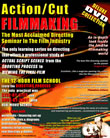|
|
FEATURES
- Writing Treatments That Sell
|
 |
|
|
|
|
|
|
|
|
| Sponsors |

|
|
|
 |
|
 |

|
|
Writing Treatments
That Sell
|

|
For someone that is new to the business of writing screenplays, the term "treatment" will most definitely be new to them as well. Basically, if a writer has an idea for a story but for one reason or another does not want to write an entire script, they'll need to know about treatments.
As stated in Kenneth Atchity and Chi-Li Wong's book, Writing Treatments that Sell, the primary functions served by the treatment in today's entertainment business are selling and diagnosing a story. This concept remains the same, whether you are selling a fast-paced thriller. For the outsider's purposes, what distinguishes one treatment from another is simply its effectiveness in making the sale, and/or laying out the story. So how exactly does one go about writing a treatment? Why do you need one and what do you put in it? What differentiates a treatment from a screenplay?
Agents, producers and movie studios receive hundreds of screenplays every year. Because of this, rarely does the buyer have the time to read each one without having some idea of what they are about to look at; hence the treatment becomes a very important selling tool. Atchity and Wong state that "second only to writing an entire screenplay or teleplay on 'spec', your treatment maybe the best tool for getting a foot in the door of moviemaking.
|

|

|
|
|
A treatment will range anywhere from one to twenty-five or more pages, depending on the kind of treatment it is and its purpose
|
|

|
|
If a screenplay focuses the story for a film, the treatment does the same thing for a screenplay. A treatment could be considered a written pitch; something that catches the buyers attention and makes then want to see more.
There are several key elements that make a treatment good and worth reading. The first is keeping it relatively brief. Generally, a treatment will range anywhere from one to twenty-five or more pages, depending on the kind of treatment it is and its purpose. The three most common kinds of treatments are Original dramatic treatments, treatments of true stories and Adaptation treatments. Another key is to keep the treatment user-friendly and straightforward.
One big difference between treatments and screenplays is that treatments are written in paragraph form where as screenplays have a very technical format. Keep the language simple yet forceful and declarative. The purpose of the treatment is to describe the events of the story so that it can be visualized and brought to life. This should be done using the least amount of words possible.
|
|

|
|
|
Shorter is Better?
|
 
|
Because the treatment is a relatively brief and loosely narrative pitch of a screenplay, it does not need to include every detail that will be in the screenplay. Therefore, the writer should highlight the major points of the story, the necessary details that are essential for the story to make sense. The treatment is just the beginning of the writing process. The writer should use it to urge the reader into asking for more, which is where the screenplay will come in.
So what turns a good treatment into a great one? A treatment can be useful in getting your story straight, as well as getting the details of the screenplay you wish to write clearly spelled out. When you begin creating the details of the script, it's too easy to lose track of the backbone of the story. The treatment focuses on the story's backbone, allowing it to be seen clearly (Atchity and Wong). The shorter the treatment is the better.
There are several aspects of a treatment that must be in place in order for a treatment to be effective. These include a solid opening that takes hold of the reader from the very beginning. There must also be a climax to the film that strikes and satisfies them. In between, there must be a protagonist (or main character) that the reader can relate to in some way. This does not mean that the main character will always be a hero or someone that the audience likes, only that the protagonist is someone that stands out and draws the audience in. The story must also contain a central conflict around which all the action in the story revolves.
|
|

|
|
| *The
FilmMakers Film Fund
will finance the production of all future film projects initiated by FilmMakers.com.
The projects will be made up of undiscovered screenwriters, directors,
producers, actors, cinematographers, music composers, first assistant
directors (AD), art directors, costume designers, production managers
(PM), etc.
To make a donation to the FilmMakers Film
Fund click on credit card button.
TO
MAKE A DONATION BY CREDIT CARD
|
|
|
| THANK
YOU FOR YOUR SUPPORT |
|
|
|
|
|
|
|
|
|

|
|
|

|

|
|
top of page
|
Home
Page |
Contests
| Indies
| Features
| News
| Resource
Links
| Advertise
With Us |
Important
disclaimer
Copyright ©
1999-2011 by FilmMakers.com. All rights reserved.
FilmMakers.com
is a division of Media Pro Tech Inc.
|

|
|
|